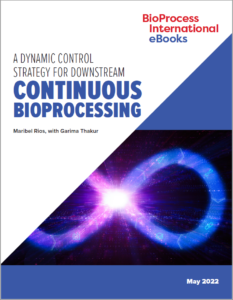Voices of Biotech
Podcast: MilliporeSigma says education vital to creating unbreakable chain for sustainability
MilliporeSigma discusses the importance of people, education, and the benefits of embracing discomfort to bolster sustainability efforts.
 Continuous processes can have many sources of variability. In downstream unit operations, changes can arise because of feed material variability, resin fouling in chromatography columns, column compression or failure, membrane fouling, depth-filter clogging, and so on. The US Food and Drug Administration’s guideline for continued process verification encourages biomanufacturers to monitor their processes and keep them under a steady state of control. One way to achieve that in continuous downstream processes is to implement a dynamic control system that adapts to process variabilities and indicate when deviations in critical process parameters occur. Such control systems maintain continuity, productivity, and robustness. Some biomanufacturers use surge tanks that hold up small volumes of material between downstream operations to prevent a process from running dry when deviations or equipment failures happen during preceding steps.
Continuous processes can have many sources of variability. In downstream unit operations, changes can arise because of feed material variability, resin fouling in chromatography columns, column compression or failure, membrane fouling, depth-filter clogging, and so on. The US Food and Drug Administration’s guideline for continued process verification encourages biomanufacturers to monitor their processes and keep them under a steady state of control. One way to achieve that in continuous downstream processes is to implement a dynamic control system that adapts to process variabilities and indicate when deviations in critical process parameters occur. Such control systems maintain continuity, productivity, and robustness. Some biomanufacturers use surge tanks that hold up small volumes of material between downstream operations to prevent a process from running dry when deviations or equipment failures happen during preceding steps.
In this eBook, BPI’s managing editor highlights a study presented at the March 2022 BPI West conference about the implementation of a dynamic control system base for continuous downstream processes. The presenter, a doctoral researcher from the Indian Institute of Technology in Delhi, showed that using surge tanks “decoupled unit operations and allowed independent controls to be executed on each unit operation using quality by design and process analytical technology approaches. Such a control system would overcome a key unexplored challenge in continuous processing, namely ‘hand-shaking’ the downstream train, accounting for variable upstream conditions by making real-time control decisions at all the various downstream unit operations.” By incorporating three surge tanks and weighing sensors into a downstream process and with applications of in-line high-performance liquid chromatography and at-line near-infrared spectroscopy (NIRS), researchers could control start-up and shut-down, enable steady-state operation, and pause a process to allow operators to repair equipment breakdowns without disrupting an entire process train.
Fill out the form below to read the complete eBook now.
You May Also Like